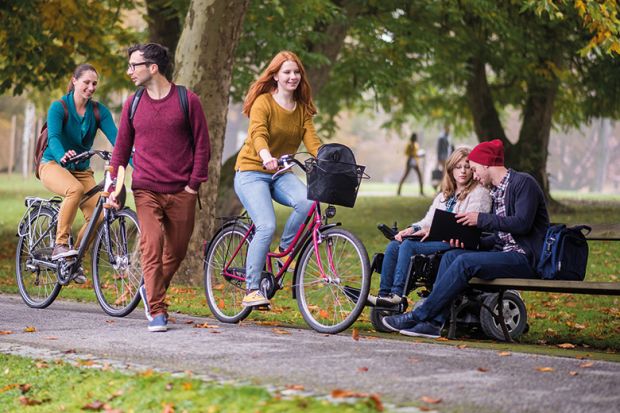Disability on campus is not a fringe issue: one in eight UK undergraduates reports some kind of disability. These students are also, on average, more likely to drop out, achieve lower grades and find it more difficult to gain immediate employment after graduation than non-disabled students.
However, meeting the needs of students with disabilities has perhaps not been helped by universities’ approaches. Rather than targeting “subsets” of students with specific additional requirements, we need to think about how we can create a more accessible, flexible and inclusive curriculum for everyone.
As lead of Anglia Ruskin University’s disability working group, established in 2014, I’ve led our work on how to build a more inclusive campus. Here are some of the lessons learned:
Engage widely
Too often we do things “to” students and not “with” them. We wanted to ensure that students were involved and, in fact, they have provided some of the most obvious yet more effective ideas.
The first meeting that I chaired had about 50 people present, all with a passion for improving this area. However, managing conversations across our three campuses, with faculties, professional service departments, our students’ union and our regional college partner is tricky, so don’t underestimate how much time listening and collating ideas will take.
Get staff buy-in
I was able to use the annual learning and teaching conference to raise awareness about disability and gather staff views on inclusive and accessible teaching and learning practices. Some of the most powerful and thought-provoking moments were provided by some of our students with disabilities. They explained what visual impairment meant for them on campus, what it was like to be dyslexic and what barriers they faced in their learning.
Hearing directly from students on what hindered them and what helped them was fantastic; you could see the faces of staff changing, realising [and] being moved.
Have an action plan
We ended up with 50 points for action but to make it manageable, we prioritised them using an “impact’ x “ease of implementation” calculation and developed what became known as “the Big 6” – things and actions that would make the quickest and biggest difference.
First on our “Big 6” list was to provide training across the institution. Some sessions had already been developed, such as around dyslexia awareness and unconscious bias training, but other sessions were new (for example, inclusive teaching practices, accessible virtual learning and learning content management). We also added workshops on “thinking inclusively” that were offered to all staff.
Change teaching materials
We created new guidelines for more inclusive and accessible learning materials. For instance, PowerPoint slides must be available two days in advance, while we now have a Senate-approved policy on Word and PowerPoint templates.
Moving our teaching materials to accessible formats was a sizeable task, so the conversion of “old” materials became a student project, while “new” materials were produced by academic staff. We employed students and provided training. They gained so much from this involvement, not only in terms of new skills and knowledge, but it meant that they could hold staff to account and question why their materials were not in accessible formats.
Make staff aware of students’ needs
Having to constantly remind or tell each and every module tutor about a disability was identified as an area of anxiety for students – “coming out” all the time was stressful and upsetting for many. So now we circulate lists of relevant students to teaching staff at the beginning of each semester.
Make it part of annual teaching reviews
Inclusive practices were added as a core and explicit criterion in annual teaching reviews: peer assessors had to comment on how well tutors used the inclusive materials policy. Heads of department are also expected to use new datasets on equality and diversity that cover protected characteristics in their annual monitoring reviews. These data on gender, disability and ethnicity are key to identifying concerns or issues in differentiated student outcomes and potential risk areas.
Overall, all these challenges have required close partnership and collaboration to make a real difference. Small steps can make a big difference. We need to stop seeing disability as a problem. After all, it’s not the students that need fixing, but our processes and systems.
Sally Everett is deputy dean (quality and student experience) at the Lord Ashcroft International Business School, Anglia Ruskin University. She has chaired her institution’s disability working group since its formation in 2014. Its work has been commended by the Higher Education Funding Council for England as a best practice case study.
Register to continue
Why register?
- Registration is free and only takes a moment
- Once registered, you can read 3 articles a month
- Sign up for our newsletter
Subscribe
Or subscribe for unlimited access to:
- Unlimited access to news, views, insights & reviews
- Digital editions
- Digital access to THE’s university and college rankings analysis
Already registered or a current subscriber? Login








